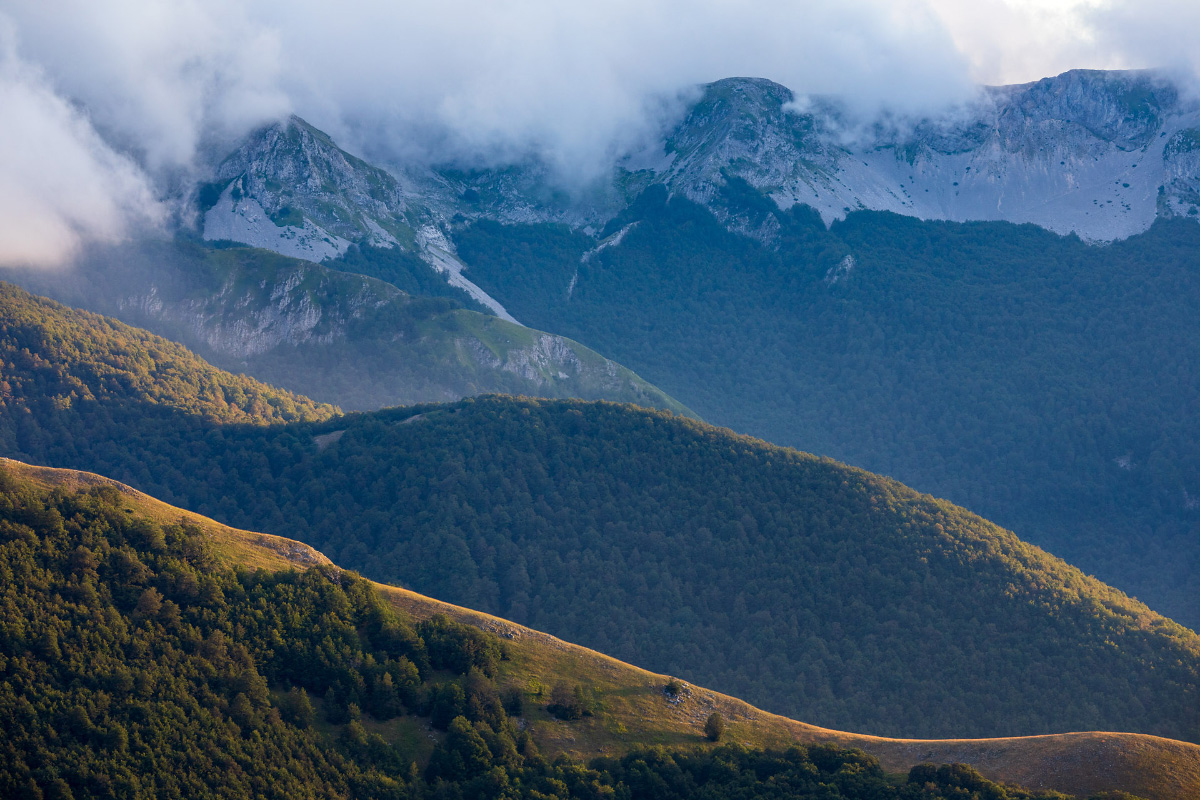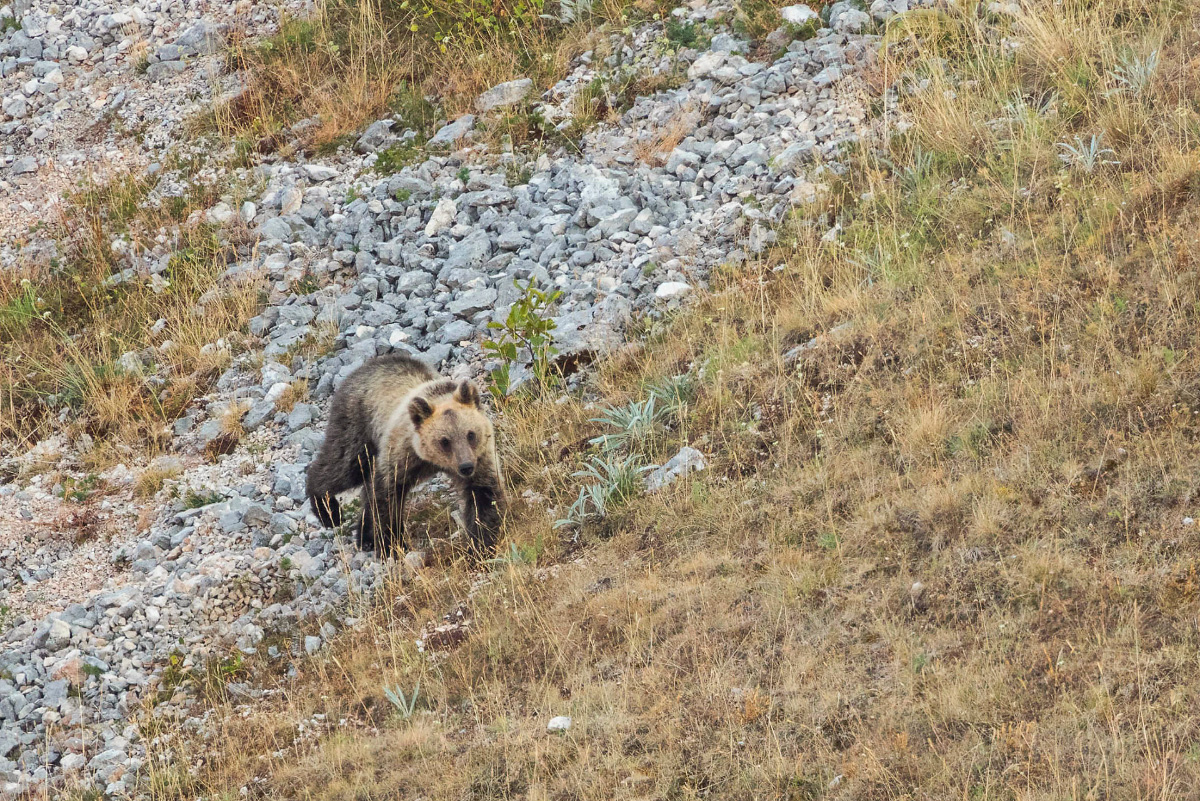A home for the bear
The movements of bears reflect their needs and vary from season to season
In the Apennines, when bears decide to settle down for life, they opt for wooded areas sparsely inhabited or frequented by people, where they can move around without too many obstacles.
Once they’ve found their “home”, bears spend their daytime hours on wooded, rugged, inaccessible mountain slopes, if possible far from roads. But with the first shadows of twilight, they also venture down to the valley floor in search of food among the pastures, meadows, uncultivated land and farmland. Bears are creatures of the night and at first light, they return to their daytime refuges. In autumn, when the need to put on weight becomes a priority, the females in particular take advantage of a few extra hours of daylight to ensure they’re in the best possible condition to become mothers. The movements of these animals basically reflect what they eat and are never random. Bears always balance costs and benefits before setting out. Any trip away from their daytime refuges must serve to fill their stomach well or find a companion.
From quiet oak woods in late winter, to mountain meadows and shady beech forests in spring, to sparse glacial moraines in summer. A bear can visit a wide variety of habitats throughout the seasons in the central Apennines.
Bears are mostly vegetarian and the foods they feed on mature at different times of the year. No season is ever the same.
When they come out of their dens in the spring, bears mainly frequent the valley floor, the edges of streams and forests and snow-free areas where they are most likely to find succulent plants, carcasses of animals that have died during the winter, or newborn red and roe deer and wild boar. Each in its own way, the bears also scour semi-natural human-derived environments such as farmland, uncultivated land and roadsides, always on the lookout for the first tufts of grass. In the first four weeks after leaving the den, the bears move around and eat little, as their metabolic functions are still slow after the long winter break, but they gradually return to normal. Between May and June, the movements of solitary adult males and females in search of amorous adventures reach their peak. On the other hand, compared to other bears, mothers stay longer at high altitudes and near their winter refuges to protect their cubs, which are still too slow to keep up. As summer progresses, between June and July, the green of the new vegetation creeps progressively higher up the mountain slopes, attracting bears to the higher-altitude grasslands in search of not just herbaceous plants, but also the ants that teem in their nests under the stones. Unlike in other seasons, to seek out the ants, most active during the hottest hours of the day, bears also frequent areas rich in shrubs and bushes assiduously during daylight hours.
The beginning of August brings with it not only an abundance of fruits, but also the peak of tourism, bringing visitors to the Park. Something also changes in the bears. They begin eating a high-calorie diet to gain weight before the long winter. At the same time, the animals lead an ever more reserved life, withdrawing to inaccessible high altitude areas both by day and by night, avoiding busy roads and crowded populated centres as much as possible. In this season, mountain glades and scree are a constant destination for bears in search of alpine buckthorn berries. But in autumn, the bears return to the woodland, uncultivated land and farmland on the valley floor in search of berries and other fruits and nuts, especially apples, pears and acorns. In years with a bumper crop of beechnuts, they limit their movements to the beech forests.
BEARS AND CLIMATE CHANGE
Recent studies have shown that a bear’s home range (the territory normally frequented by the bear in a year or season) should contain at least 10% open space and the rest woodland in order to provide all the food necessary for its survival (acorns, beechnuts, berries, apples, pears, herbaceous plants and ants). Climate change models predict that over the next 40 years, average temperatures in Europe could rise by up to 2°C, with a parallel increase in heavy rainfall during the spring and severe droughts in summer. In this scenario, over the next few decades, bears will have to adapt to a great many changes: more forest cover, fewer open spaces and a transformation of beech forests to oak woods. The dietary flexibility of bears in the Apennines and the diversity of the foods they feed on certainly give these animals an ace up their sleeve to survive these changes. But the situation needs close monitoring, because every plant can react differently.

The homes where bears live must meet many requisites and satisfy all their needs for food, safety and reproduction.
In the Apennines, each individual bear is different and the size of home range can differ up to three times between males and females. The home ranges of Marsican bears can vary between 30 and 300 km2 and they are in every way comparable to those of brown bears living in areas even more productive than the Apennines.
WHAT IS A BEAR’S HOME CALLED?
Every living being has its own home range, in other words, an area where it habitually eats, breeds and looks after its offspring. An ideal home range is one where you can find a companion to mate with, sufficient food resources and areas safe from competitors and predators. For bears, the concept of home range is very dynamic and both its size and use may differ greatly, depending on annual and seasonal variations in the most palatable foods, health and reproductive status of the animals, presence of competitors and disturbance factors, such as, for example, human infrastructure. Some areas, usually coinciding with refuge and feeding areas, are used more often than others and are known as core areas.
The home range can be measured in many methods. The Minimum polygon complex draws a polygon around the extreme localizations of a bear’s range, while the kernel methods draw a boundary around the most intensively areas used by a bear. See the map.

Bears always use the same central areas from one season to the next, but their home range may shrink, expand or lengthen depending on their reproductive and nutritional needs and the distribution of the most palatable food. The most significant changes have been observed at the transition between summer and autumn, when it may halve or even double, depending on the bears or the years. In autumn, bears feed mainly on nuts and the abundance of these may vary greatly from year to year. For example, when there is a bumper crop of beechnuts, bears limit their movements to the beech forests, staying for weeks on end in even very small areas. Their territories will therefore be smaller than in years when the beech forests produce few beechnuts.
Males always have larger territories than females. In particular, during the breeding season between late spring and early summer, adult males double their movements to reach and mate with as many females as possible, in accordance with a polygamous reproductive strategy. Males expand their territories to include up to six different adult females. While females with young tend to restrict their movements in the early summer months to reduce the risk of infanticide by adult males, in the other seasons they expand the areas where they live to meet the nutritional needs of the whole family.
Bears are not exactly territorial and tolerate each other, although they know when and how to share out the space so as not to overlap excessively.
Bears tolerate each other and can share the same home, but season and personality play a role. The most tolerant are mainly the females which tend to remain in the same territory as their mother, while males are driven to disperse in their early years. For example, in the Park, a bear may encounter 4 other individuals in every 100 km2. The fact that bears in the Apennines are very indulgent towards each other is evident in both summer and autumn, when gatherings of up to nine bears can be observed together within a few square kilometres. However, overlapping does not necessarily mean frequenting the same areas on the same day or at the same time. Bears are, in fact, very adept at dividing up the calendar of presences in a specific area. On the other hand, if they cannot avoid a sometimes close encounter, they know how to interact to prevent tension and conflict.
The bears are “packed in tightly” in the Park, suggesting that this area will not be able to accommodate more bears than there are already.
Given the high extent to which the home ranges of bears in the Park overlap, it seems reasonable to assume that these animals are beginning to feel a little “cramped”. What can happen to the bears in a situation like this? Younger bears are generally driven away to marginal areas or to seek out new territories further afield, while for those that remain, control mechanisms may come into play, for example, to limit births. Older dominant females may exercise their authority to prevent younger females from reproducing, or the cubs may fall victim to more cases of infanticide by adult males. What evidence is there for the bears in the Park? The low reproductive rates in the females and more recent phenomenon of young bears frequenting built-up areas indicate that such a phenomenon is taking place. In recent years, there have been more and more reports of male and female bears outside their habitual distribution area. A good indication that bears are being driven to move away from the areas where they are usually present.
BEARS ELSEWHERE
In bears, dispersal (moving away from the maternal territory) is a purely male phenomenon. Typically, more than 90% of males move away in dispersal within the first 5 years of live, travelling even hundreds of kilometers. Playing on their home pitch, in other words, remaining in a territory where they know every blade of grass, is very advantageous for a female who must stay fit and healthy in order to reproduce. Females remain much more attached to their mother’s territories (a phenomenon known as philopatry) and rarely stray more than 70-80 km from where they were born. Bears looking for new territories, or arriving in areas with a low density of bears and therefore little competition, may occupy territories up to three times larger than they would have occupied in the area where they were born, especially if they are forced to move in highly fragmented areas.

Throughout history, man has always altered the natural habitats of the Apennines, and the Park represents a true mosaic of environments.
Despite the observed tendency of bears to prefer home ranges with natural environments, roads and built-up areas can occupy up to half the territory of some bears. So for a bear, frequenting areas inhabited by man is actually not so strange. Some bears regularly cross villages, although they do so at night. This behaviour can be exacerbated when young bears and females with cubs choose to live near these areas to escape the males. When this happens, also considering the presence of factors of attraction in populated places, such as fruit trees, some bears may lose their fear of humans and become accustomed to living in less wild areas.
Se ad un orso si offre la possibilità di accedere liberamente ad alberi da frutto non protetti, all’interno di un centro abitato, questo potrebbe scegliere di tornare ad una tale risorsa e perdere via via la naturale diffidenza nei confronti delle persone. È così che nascono gli orsi cosiddetti “confidenti”, i cui movimenti vengono monitorati con radio-collari per prevenire eventuali incidenti.
However, the bears’ habit of feeding near roads or villages, whether on natural foods (herbaceous plants and insects) or human-derived food resources, is a potential risk for the species and associated with both high levels of conflict with man’s activities (such as damage to livestock, gardens and orchards) and a greater risk of bears being killed (hit by cars or killed by poachers). What’s more, out of the 19 bears monitored, the home ranges of more than half include large areas with limited protection and with a heavier human presence than those within the Park. On the other hand, 100% of the territories of bears in dispersal or frequenting areas outside the Park may coincide with risk areas, with all the dangers this entails.
Within their home range, bears frequent areas that may represent a high risk for their survival, although they may be very attractive. These areas, defined as ecological traps, characterise a large part of the future territory of potential Apennine bear expansion.



